Racing Sails
Ultimate racing sails are produced after detailed research and development, both on and off the water. Our design and technology programme is second to none and innovative sail development has been our foundation.
Every sail is designed to your own boat, rig and crew. We listen to your ideas and discuss all the options available before agreeing to the final design and specification. That interaction is the key to our enviable track record of designing and delivering the most successful racing sails.
We offer no limitations on design and every Racing Sail we produce is suited your exact requirements using highly sophisticated software tools and drawing from a database of 15,000 designs compiled over 25 years.
Mainsails
When it comes to racing the best option for your upwind sails is to use a Lightwave Membrane. The strength to weight, shape retention and outright performance are second to none and results speak for themselves.
We offer a range of options and will customise every design to suit the type of racing you will be competing in. We will provide you with the fastest racing sails fully optimised for any style of racing including shorthanded, offshore, fully crewed one design and IRC / ORC.
Standard features include:
- Boltrope
- Telltales
- Leech battened mainsail – 1 full-length batten
- Draft stripes
- Cunningham
- Leech and foot lines with cleats at reef points
- Drawstring bag
- Sail numbers
Optional extras:
- Third reefing point
- Class insignia
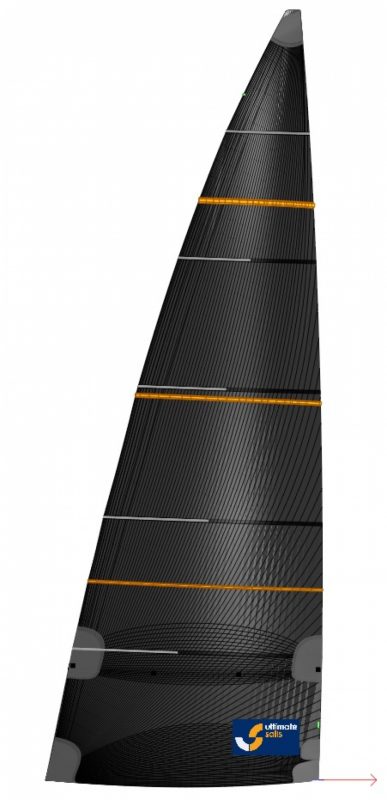
Headsails
There’s a range of overlapping and non-overlapping headsails from Ultimate Sails. They range from the largest genoa up to 150%, down to a non-overlapping Code 3.5 jib, the smallest jib made of heavier cloth to withstand stronger winds.
Getting your sail wardrobe right is fundamental and there is plenty of choice when it comes to headsails. The correct headsail choice will do wonders for your rating, it will also provide you with optimum power across the wind range and sea conditions, enabling you to maintain straight-line speed, height and maneuverability. Ultimate Sails offer a range of non-overlapping headsails including the Code 1, 1.5, 2, 2.5 and 3.5.
Code 1 Jib – Max AWS kts: 15
Code 1.5 Jib – Max AWS kts: 18
Code 2 Jib – Max AWS kts: 22
Code 2.5 Jib – Max AWS kts: 25
Code 3 Jib – Max AWS kts: 30
Code 3.5 Jib – Max AWS kts: 35
When racing under IRC or ORC rules this sail qualifies as a heavy weather Jib and it comes with back up eyelets in luff if required.
Standard features include:
- Telltales
- Battens (Vertical for furling headsails)
- Draft stripes
- Leech and foot lines with cleats
- Sail bag
Optional extras:
- Sail numbers (for overlapping Genoas)
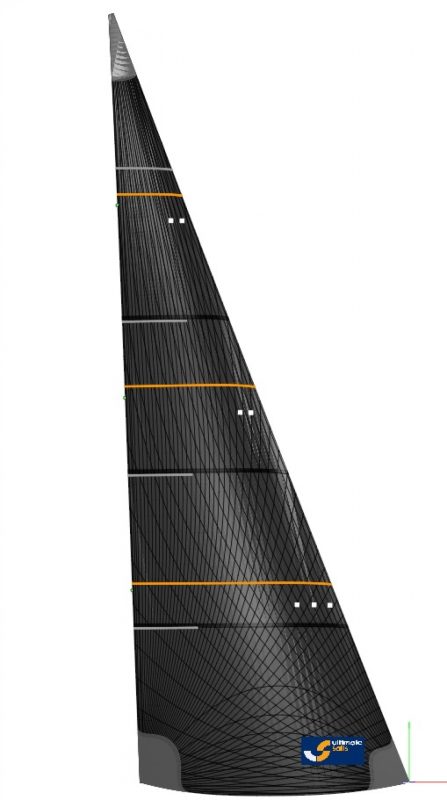
Reaching Racing Sails
 The average IRC yacht now has non-overlapping headsails which can be in-hauled and a medium roach maisail and can go upwind very effectively in all but the lightest of conditions. Downwind they use large spinnakers and also have good performance resulting in a set-up which works perfectly for windward-leeward racing. The problem these boats have is that the jibs are not hugely effective off the breeze and their large spinnakers are too deep to sail tight angles resulting in a large range of angles where you are unable to sail 100% of your boat targets. For anyone racing offshore or around the cans regattas like Cowes Week, this is a real problem as they are potentiallially giving away a lot of time on the water.
The average IRC yacht now has non-overlapping headsails which can be in-hauled and a medium roach maisail and can go upwind very effectively in all but the lightest of conditions. Downwind they use large spinnakers and also have good performance resulting in a set-up which works perfectly for windward-leeward racing. The problem these boats have is that the jibs are not hugely effective off the breeze and their large spinnakers are too deep to sail tight angles resulting in a large range of angles where you are unable to sail 100% of your boat targets. For anyone racing offshore or around the cans regattas like Cowes Week, this is a real problem as they are potentiallially giving away a lot of time on the water.
Luckily under IRC, the penalty for additional spinnakers is low and there is no penalty for additional jibs, as only the largest is measured. As a result, there are two great options to turbo-charge your reaching performance and always be able to sail at 100% of targets no matter what the wind angle.
Jib Top (and Genoa Staysail)
 A Jib Top is a high clew jib designed for reaching in medium to strong winds. Any time you would normally be using your jib with an outboard lead the jib top will be the fastest option. This sail fills the gap between the normal jib and the IRC Code 0.
A Jib Top is a high clew jib designed for reaching in medium to strong winds. Any time you would normally be using your jib with an outboard lead the jib top will be the fastest option. This sail fills the gap between the normal jib and the IRC Code 0.
We have spent a lot of time at Ultimate Sails developing our Lightwave Jib Top, and it has proved a fast and cost-effective addition to the sail wardrobe. Relatively recent rule changes mean you can now fly a jib top from a bowsprit or spinnaker pole, this has made this sail even more effective, widening its wide angle range and increasing performance. The sail can be supplied with an anti-twist rope and used with a furler for fast and easy handling.
Apparent wind angle range: 60 – 120 degrees
Apparent wind speed range: 12 – 25 knots
A Jib Top is a high clewed reaching rib which is much more efficient once the sheets are eased and used between a Code 0 and a jib in over 12 knots TWS.
it is sized the same as your largest jib so there is no rating penalty. Jib Tops are traditionally flown from the forestay bit on boats with a bowsprit it has become more popular to them on a torsion cable forward of the bow.
 Combining the Jib Top and the Genoa Staysail increased and pushes the area of the sail plan forward, helping to balance up the helm when the boat is pressed on a reach. In above 22 knots this sail combination is incredibly fast. In combination with a reefed main the boat is perfectly balanced and much faster than using a smaller headsail and full main (20 knots TWS sail performance comparison chart).
Combining the Jib Top and the Genoa Staysail increased and pushes the area of the sail plan forward, helping to balance up the helm when the boat is pressed on a reach. In above 22 knots this sail combination is incredibly fast. In combination with a reefed main the boat is perfectly balanced and much faster than using a smaller headsail and full main (20 knots TWS sail performance comparison chart).
JT / Staysail Race Example
It’s the Dieppe race and your turn onto the final leg, a reach from Brighton to the finish in Dieppe. In the prevailing wind direction and the breeze in the English Channel is a solid 20 knots. A Jib Top would be the perfect sail for the 65 mils leg at 95-100 degrees TWA and 18-22 knots TWS. Performance is 8-10% faster than you would manage under a J3.
If you aren’t sure that 8% sounds that much, consider the numbers. In your 40 footer you would be able to maintain 10 knot average speed with the J3 but with the jib top and genoa staysail the speed has jumped to 10.8-11 knot average. You save half an hour over the leg for no penalty on your rating.
IRC Code 0
 The IRC code 0 fills the gap between the widest effective wind angle of a headsail and the narrowest wind angle of a reaching downwind sail (approx. 35 to 95 degrees TWA). SIzed approximately halfway between a jib and a spinnaker, the IRC code 0 is incredibly versatile and should be the first port of call for anyone looking to build a reaching sail wardrobe.
The IRC code 0 fills the gap between the widest effective wind angle of a headsail and the narrowest wind angle of a reaching downwind sail (approx. 35 to 95 degrees TWA). SIzed approximately halfway between a jib and a spinnaker, the IRC code 0 is incredibly versatile and should be the first port of call for anyone looking to build a reaching sail wardrobe.
It’s the flattest sail you can have that still measures as a spinnaker (with a mid-girth of more than 75% of the foot length) so it doesn’t affect your IRC rating as long as you don’t carry more than your spinnaker quota.
An IRC code 0 in the inventory typically adds 10% to 20% more speed in sub 10 knot conditions., and they can be flown from a bowsprit, a spinnaker pole or direct from the bow of a boat. These sails can be used for very tight reaching in light and medium winds and for broader reaching in up to 20 knots. They can easily increase performance by 10% in comparison to a jib at tighter angles than a spinnaker can be carried.
Our on the water testing programmes have developed IRC Code 0’s that sail closer to the wind than ever envisaged.

Apparent wind angle range: 35 – 100 degrees
Apparent wind speed range: 5 – 20 knots
Depending on your boat it is possible to have either a fractional or masthead Code 0. This is based on the boat’s performance characteristics, where it will fit into the existing sail inventory and the halyards available. The sail can be flown from a bowsprit or from the spinnaker pole and either be on a furler or launched out of a bag like a normal spinnaker.
IRC Code 0 Example
 You have just rounded Fastnet Rock and are heading tot he turning mark. It’s 15 knots and the 165 mile leg back to the Scillies is about to commence. It’s prevailing wind conditions so the wind angle is between 100 and 120 degrees TWA.
You have just rounded Fastnet Rock and are heading tot he turning mark. It’s 15 knots and the 165 mile leg back to the Scillies is about to commence. It’s prevailing wind conditions so the wind angle is between 100 and 120 degrees TWA.
Normally you could cruise along at 10 knots if you were lucky. The boat would feel a little dead under the J2 and if you get a little low the performance really drops off a cliff but it’s still too tight for any of your spinnakers. May you would decide to sail a little high then pop the spinnaker later?
Not to worry though. This time you have a Code 0. You unfurl and off comfortably averaging 11.5 knots straight down the rhumb line. The boat feels great and you leave anyone under your jib in your wake. Suddenly the leg takes 14 hrs 20 mins rather than 16 hours 30 mins. Because you looked at the forecast and knew this leg would arrive you fitted the Code 0 into your quota of spinnakers and saved at least 2 hours 10 mins for no rating penalty! (14 knots TWS performance comparison chart)
These are fairly common scenarios in offshore racing so it is worth looking at the events in your calendar and seeing if a specialist reaching sail could make the difference and get you on the podium. There is nothing more frustrating than losing 2 hours plus in a race because you didn’t have the right sail inventory.
 We can provide a sail polar chart for your boat to show where in the inventory these sails could fit and what the best option for you is. This will depend on your boat and the events you race in.
We can provide a sail polar chart for your boat to show where in the inventory these sails could fit and what the best option for you is. This will depend on your boat and the events you race in.
Where once these sails were uncommon, it is now incredibly risky not to carry them for offshore or point to point racing. We are often asked how much difference IRC Code 0 can make so have developed out comparison charts to help show relative performance of these sails.
We love to develop specialist sails for specific boats and campaigns and enjoying nothing more than seeing happy customers on the podium of the biggest events. Don’t just makeup fleet numbers, take home the silverware.
Downwind Sails

If you want to maximise the downwind performance of your boat then an Ultimate Sail is the perfect choice. For many seasons we’ve designed and produced some of the fastest downwind sails seen on the race track. At the same time, our last generation of running Asymmetrics can run at the same deep angles as an asymmetric spinnaker.
Our advanced sail design program moulds the perfect sail in size and shape prior to manufacture. All sails are manufactured using our unique full radial multi-panel layout and are constructed from the best nylons. The result is a sail with a smooth flying shape that is stable and easy to trim.
Corner loads are addressed by specially engineered layered radial patches which help to spread the loads through the sail more evenly and absorb the shock loads inherent in all downwind sails.
 We use a coding system for downwind sails which categorises sails by their purpose and wind range than by cloth weight. This has the advantage of being logical and transferable across a range of different boats.
We use a coding system for downwind sails which categorises sails by their purpose and wind range than by cloth weight. This has the advantage of being logical and transferable across a range of different boats.
Even numbered sails are runners designed to sail at the deepest angles possible and the odd-numbered sails are designed for reaching. The higher the code number the higher the wind speed each sail is designed to operate. S stands for Symmetric Spinnakers and A is for Asymmetrics. This chart shows the range of wind angles and speeds for a full inventory of Asymmetrics.
Code 1 Symmetric / Asymmetric
When you are looking to maximise downwind performance in light winds an Ultimate Sails A1 or S1 is the perfect choice. The design has been perfected through careful optimisation of the shape which has a very smooth camber profile across the sail. Further development of the luff shape and leech twist allow the sheet to be eased a long way opening up the upper leech of the sail and helping acceleration which is especially fast in light and variable winds.
Apparent wind angle range: 60 – 140 degrees
Apparent wind speed range: 0 – 8 knots

Code 2 Symmetric / Asymmetric
The Ultimate Sails A2 or S2 is the workhorse of a downwind sail inventory and a must for light to medium winds when the angles sailed change dramatically with only a few knots increase in wind speed. It’s a versatile design that is fast and easy to trim. The design has been perfected through careful optimisation of the shape which has a flatter profile head which makes the sail more stable in VMG conditions.
Apparent wind angle range: 100 – 160 degrees
Apparent wind speed range: 7 – 13 knots
Code 3 Symmetric / Asymmetric
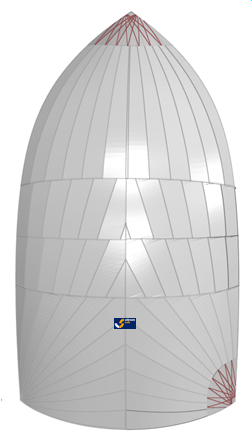
If you want to maximise the downwind performance of your boat when reaching in medium winds then the Ultimate Sails A3 or S3 is the perfect choice. This sailing is ideal for any kind of point to point racing or for VMG sailing in boats where the apparent wind is dragged forward.
Apparent wind angle range: 70 – 120 degrees
Apparent wind speed range: 9 – 15 knots
Code 4 Symmetric / Asymmetric
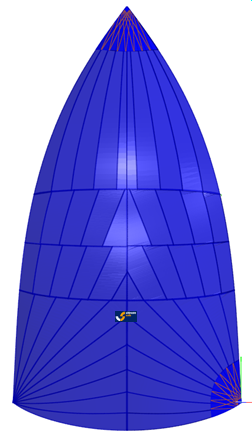
If you are looking to add more horsepower to your boat when sailing downwind in medium to strong conditions then the Ultimate Sails A4 or S4 is the perfect choice. The versatile design has won a reputation for being both fast and easy to trim and it’s been refined over many seasons so that is it excels when running at deep angles. The design has been perfected through careful optimisation of the cambers on the edges which give greater projection and stability when running.
Apparent wind angle range: 50 – 140 degrees
Apparent wind speed range: 10 – 18 knots
Code 5 Symmetric / Asymmetric
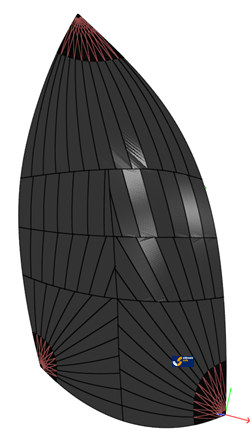
If you want to maximise your downwind performance when reaching or in strong winds then the Ultimate Sails A5 or S5 is the perfect choice. The versatile design has been refined over many seasons so that it is easy to trim in stronger winds.
Downwind standard features include:
- Radial patches
- Coded tapes
- Launch bag
- Spectra luff line
- Torsion cable (Code 0 only)
- Sail numbers
Optional extras:
- Sail branding
- Tack prodder
- Take down patch
- Furling systems

Cruising, Racing and
Lightwave Endurance Sails
Online Instant Quote Generator
No pressure. No obligations. Instant

